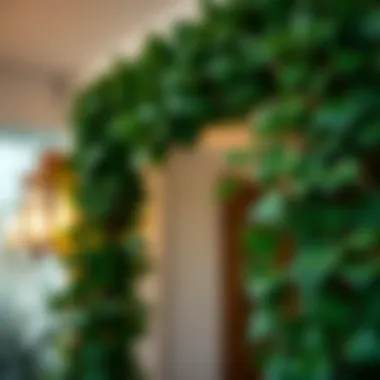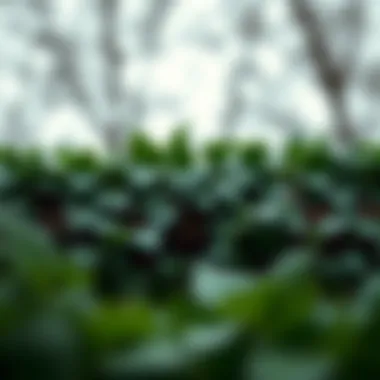Exploring the Symbolism and Use of Ivy Leaves Garlands


Intro
Ivy leaves garlands have long been more than a mere decorative choice; they embody a patchwork of history, symbolism, and art. Rooted deep in ancient traditions, ivy symbolizes fidelity, friendship, and eternal life. In various cultures around the globe, it has served as an emblem for both joyous occasions and solemn ceremonies. Today, these garlands have made a dazzling return to the forefront of contemporary fashion and design, demonstrating their versatility beyond just seasonal adornment.
This article will unravel the intricate layers of ivy leaves garlands, illustrating their multifaceted significance from historical contexts to modern applications. As we move through the various sections, we will look closely at current fashion trends, relevant styling techniques, and the craftsmanship involved in creating these garlands. Readers, especially designers, stylists, and fashion students, are encouraged to engage with the material, as we explore the intersection where nature meets style.
Clothing Trends Analysis
Current Trends in Seasonal Fashion
Ivy leaves garlands have seen a revival in fashion that is reflective of current trends toward sustainability and natural aesthetics. Designers are increasingly turning to biophilic design principles, where natural elements are entwined with clothing styles to create a calming yet sophisticated look.
You may observe that many fashion houses now incorporate ivy motif patterns in their textile designs, facilitating a visual connection to nature. Seasonal collections often integrate these elements as a subtle nod to ongoing discussions surrounding ecological awareness within the fashion industry.
Iconic Styles Through Decades
Throughout the decades, ivy leaves have manifested differently within fashion while maintaining their core symbolism. The 1960s embraced bohemian styles, and ivy garlands were used as headpieces, symbolizing free-spiritedness. Fast forward to the '90s, when grunge made its mark; wooden beads with ivy leaves adorned many festival outfits, blending casual chic with a touch of nature.
As nostalgia casts a shadow on today’s sartorial choices, it's no surprise that designers frequently revisit and reinterpret classic styles like those influenced by ivy.
Styling Tips and Techniques
Essential Tips for Wardrobe Versatility
Creating a wardrobe that showcases ivy leaves garlands requires a keen eye for detail and understanding of layering. Here are a few essential tips to effectively incorporate these garlands into your outfits:
- Choose the Right Material: Opting for handmade garlands using natural ivy provides an organic feel, enhancing aesthetic appeal.
- Mix and Match: Pair ivy garlands with contrasting colors, which can make the greenery pop while maintaining elegance.
- Versatile Layers: Adding layers creates depth. A simple tee with an ivy garland may transform into an evening look with a tailored jacket.
Layering Techniques for Effortless Looks
Implanting ivy leaves within layers can create stunning visual effects. Here are a few layering techniques:
- Statement Piece: Use a bold ivy garland as the statement piece to draw attention. Keep other pieces minimal for balance.
- Color Coordination: Select garments that either complement or contrast with the hues of the ivy leaves, ensuring harmony in your ensemble.
- Casual Chic: Pair a loose-fitting dress with an ivy garland that hangs effortlessly, evoking a laid-back vibe while maintaining sophistication.
Prelims to Ivy Leaves Garlands
In the realm of design and decor, ivy leaves garlands are more than just an aesthetic choice. They bring a depth of meaning and versatile utility that makes them suitable for various settings. From home décor to fashion statements, understanding the nuances of ivy garlands offers insights into their longstanding relevance. This section introduces the core elements surrounding ivy leaves garlands, emphasizing their significance in artistry and nature.
Definition and Characteristics
Ivy leaves garlands are decorative strands made primarily from ivy plants. These garlands possess a unique feature characterized by their heart-shaped leaves that symbolize eternity and fidelity. Traditionally, ivy is often associated with various meanings across cultures, including commitment and growth. In crafting these garlands, the plaiting of ivy vines together creates a stunning visual, capturing the essence of lush and vibrant nature.
Besides their visual appeal, the durability and flexibility of ivy make these garlands a popular choice among decorators and designers. They can be draped, tied, or hung to suit various styles ranging from rustic to modern. The lush greenery adds a touch of natural elegance, making them versatile for numerous occasions.
Historical Context
The Role of Ivy in Ancient Cultures
In ancient cultures, particularly within Greek and Roman societies, ivy held a significant place. It was revered not just for its beauty, but for its symbol of immortality and eternal life. This association with the divine made ivy an ideal representation in celebrations and rituals, particularly in honoring Dionysus, the god of wine and revelry. The leafy tendrils of ivy were intertwined in crowns and garlands, serving as a reminder of life's fragility and the enduring nature of love.
This historical use of ivy underscores the long-standing popularity of ivy leaves garlands and their ability to convey deeper meanings. Its intertwining nature mirrors the complex relationships that humanity shares, binding together various emotions like commitment, passion, and resilience. The use of ivy in ancient cultures showcases its appeal as a symbol of life that transcends generations—an outcropping of tradition that many still embrace today.
Symbolism of Ivy in Literature and Art
The symbolism of ivy has woven its way into numerous literary and artistic works throughout history. It often appears as a motif representing fidelity, as well as the intertwining of human connections. Artists and writers have utilized ivy vines to depict the entanglements of love, passion, and even the passage of time.
For instance, in the works of Shakespeare, ivy plays a subtle role in setting the scene for themes of loyalty and devotion. Its lush growth can symbolize growth beyond barriers, portraying the depth of human experience. This literary use ensures that ivy, and by extension ivy leaves garlands, resonate with meanings that are not only beautiful but profoundly relatable.
The ability of ivy’s symbolism to extend into contemporary interpretations solidifies its relevance. The unique aspects of ivy in artistic compositions remind us to reflect on the relationships we cultivate with others and the surroundings we inhabit. Thus, ivy leaves garlands serve as more than mere decorations; they encapsulate the stories of those who have come before us, bridging the gap between the past and present.
Through its historical legacy, ivy offers a rich tapestry of meanings that can enhance any design, inviting individuals to reflect and reconnect.
Cultural Significance of Ivy Leaves


The cultural significance of ivy leaves is profound, transcending mere aesthetics to engage with themes of love, endurance, and resilience. Ivy is not just a decorative plant; it embodies deep-rooted meanings that resonate across various cultures and epochs. Understanding the implications of ivy can bolster the appreciation of its role in art, mythology, and everyday life, making this exploration pivotal for designers, stylists, and fashion students alike.
Ivy and Its Symbolic Meanings
Growth and Fidelity
Ivy leaves are often associated with both growth and fidelity, symbolizing the steadfastness of bonds—be they romantic or platonic. This quality of ivy is significant, particularly in ceremonies such as weddings, where it represents unyielding love and commitment. The unique aspect of ivy growing in a twisting, climbing manner signifies not only physical growth but also the emotional and psychological intricacies of relationships.
For designers, incorporating this symbolism into wearable art or decor can enhance the emotional value of their pieces. A designer might opt to use ivy garlands in wedding gowns or bridal accessories, imparting a deeper meaning to what could have been a straightforward design.
However, the intense imagery that ivy invokes may also bear a downside: over-sentimentality. Some critiques argue that relying on traditional symbols can render a design predictable or clichéd. Thus, while ivy is a popular choice, there’s a fine line between using it effectively and falling into the trap of commonality.
Immortality and Durability
Another aspect of ivy, closely tied to its nature, is the theme of immortality and durability. Ivy is a plant that can thrive in a variety of conditions, symbolizing resilience. This characteristic particularly aids in projecting the idea that love and friendship can withstand trials and tribulations, just as ivy endures harsh weather or neglect.
In contemporary fashion, this symbolism can be harnessed through intricate designs that reflect durability—not just in terms of the garments' longevity but also in their emotional relevance. Designers can create collections that tell a story of survival through hardship, appealing to consumers looking for deeper connections with their clothing.
Interestingly, while ivy’s durability is an asset, it can also carry a cautionary note about over-exposure. Designers may find that they need to balance the inherent symbolism of ivy with freshness to keep their work from feeling stale. A thoughtful approach to this aspect will allow for new explorations of design that remain steeped in meaning, enriching the overall narrative.
Regional Variations in Symbolism
European Traditions
In European cultures, ivy has long been associated with ancient customs, particularly at festivals and during weddings. Historically, ivy decorated the walls of homes during New Year celebrations, acting as a harbinger of luck and longevity. The key characteristic of protection from evil spirits makes ivy a staple in various European decorations, especially during Christmas.
The distinct advantage of leveraging ivy in European design is its rich narrative history. Incorporating ivy in modern interpretations of traditional European costumes not only enhances their historical fidelity but also resonates with an audience who appreciates depth in cultural references. However, designers must be cautious of the stereotype that ivy brings; it could be seen as overly sentimental, potentially alienating a more modern audience.
Asian Interpretations
Contrastingly, in many Asian cultures, ivy tends to symbolize survival and tenacity. For instance, in Chinese art, ivy is often tied to prosperity, as the plant thrives in challenging circumstances. The aesthetic of ivy found in various Asian textiles demonstrates an awareness of the difficulties faced, imparting resilience in their designs—a vital perspective among fashion students who aim to blend longevity with creativity.
Incorporating these Eastern interpretations into design can offer a refreshing lens, allowing Western designers to explore new materials and motifs. However, it also presents a challenge: ensuring an authentic representation without appropriating cultural symbols. Designers must tread carefully to avoid misrepresentation, ensuring that their designs honor the history and lineage of ivy in these traditions.
Overall, understanding the cultural significance of ivy helps illuminate its role in garlands and beyond. Through such exploration, one discovers not only elements of design but the values and stories that can inspire contemporary fashion.
Crafting Ivy Leaves Garlands
Crafting ivy leaves garlands is a vital aspect of understanding their use and significance in various realms, especially decor and fashion. Garlands made from ivy leaves can transform ordinary spaces into extraordinary ones, adding a touch of elegance and natural charm. Beyond aesthetics, the crafting process can hold a deeper significance, tying in themes of sustainability, creativity, and cultural representation. Understanding how to craft these garlands not only enriches one’s appreciation of nature but also empowers one to make stylish statements.
Materials Used
Natural vs. Synthetic Options
When it comes to materials used for crafting ivy garlands, a choice exists between natural ivy leaves and synthetic alternatives. Natural ivy leaves bring a genuine organic feel, connecting the user to nature itself. With their vibrant shades of green and texture, fresh ivy leaves can create a visually appealing garland that exudes authenticity. However, there’s a catch—real leaves tend to wilt and may require special care.
On the other hand, synthetic options, while lacking some of the charm of real ivy, provide a longer-lasting solution. Materials like high-grade plastic can replicate the look of ivy quite effectively. This not only ensures longevity but also allows for greater versatility in design. The large upside to these synthetic choices is their durability; they’re resistant to fading and the effects of moisture, making them ideal for outdoor uses.
Ultimately, the choice between natural and synthetic reflects personal preference and the desired longevity of the garland. The unique aspect of combining both can lead to innovative designs that carry the benefits of both worlds.
Considerations for Sustainability
Considering sustainability in crafting ivy garlands is crucial in today’s eco-conscious environment. Choosing materials that are sourced responsibly can positively contribute to reducing environmental impact. Natural ivy leaves sourced locally can minimize carbon footprints and support local communities. Furthermore, there are many initiatives that ensure harvesting methods do not threaten the plant’s ecosystem.
With synthetic options, the focus shifts to the longevity of the items. While often critiqued for being less eco-friendly, many synthetic materials now come from recyclable plastics. The adaptation of using biodegradable alternatives in crafting can also signify a step toward sustainable practices. The unique feature here is that environmentally-conscious consumers can now choose materials that do not sacrifice aesthetics for ethics.
Techniques in Crafting
Traditional Methods
Traditional methods of crafting ivy garlands offer a lovely connection to artisanal practices. These methods often involve hand-woven techniques where fresh ivy leaves are intertwined with twine or string. Using hands to weave creates a tactile relationship with the materials, allowing for individual expression in design. This method may take time and patience, but it can yield a masterpiece that reflects personal creativity.
Crafting a garland this way allows one to explore patterns and shapes in a very organic way. The charm lies in the subtle imperfections that make each garland unique. One downside, however, is the garland's limited lifespan, particularly if real ivy is used without proper maintenance.


Modern Innovations
In contrast, modern innovations in crafting have introduced new tools and techniques that marry tradition with technology. Tools like hot glue guns and wire frames can simplify the crafting process considerably. One popular method involves using artificial ivy leaves, which can be glued onto a frame, allowing for customizable lengths and styles.
The unique aspect of modern innovations is the potential for greater creativity. Designers can experiment with colors, shapes, and sizes that were previously difficult to achieve with traditional methods. However, one might argue that this approach could detract from the natural authenticity inherent in traditional crafting methods.
Crafting ivy garlands, whether through traditional or modern techniques, opens a window into a blend of art, culture, and sustainability. The choices made during this process play a major role in defining the beauty and symbolism associated with these garlands.
Ivy Leaves Garlands in Fashion
Ivy leaves garlands have become prominent in the realm of fashion, acting as both adornment and inspiration. Not just mere decorations, these garlands signify a bridge between nature and style. Their intricate aesthetics bring a sense of organic elegance to wardrobes, allowing individuals to express personal identity through unique designs. This section unfolds the various aspects of incorporating ivy leaves garlands into fashion, exploring how these natural elements can influence contemporary trends.
Incorporating Ivy into Wardrobe
Accessories and Statement Pieces
In today's fast-paced world of fashion, accessories do a heavy lifting when it comes to personal style. Ivy leaves can be transformed into stunning statement jewelry, adding an exquisite touch to any outfit. Necklaces, earrings, and bracelets featuring ivy designs not only showcase individuality but also bring nature directly into fashion. One key characteristic of these accessories is their eye-catching complexity, often featuring delicate vine patterns that capture light beautifully. This makes them a popular choice among those seeking an organic yet stylish flair.
The unique feature of ivy accessories lies in how they embody a fusion of elegance and natural beauty. They are ideal for both casual and formal wear. However, it’s essential to note that while these pieces can elevate an outfit, their delicate nature often requires careful handling, which could be seen as a disadvantage for some. Nevertheless, many find the fragility adds to the overall charm.
Versatile Styling Options
When it comes to styling, ivy leaves garlands offer flexibility that is hard to beat. One significant aspect is their ability to complement a myriad of outfits, from bohemian dresses to sharp, tailored suits. This versatility reflects the current trend of mixing and merging styles, allowing wearers to experiment with their looks. Ivy garlands can be worn in hair, draped around necklines, or even incorporated into belts, providing endless options for creative expression.
A distinct feature of these styling options is that they cater to various occasions. Whether it’s a casual outing or a sophisticated event, ivy can transform the vibe of an ensemble. The downside, though, is sometimes these garlands are perceived as seasonal, primarily aligning with spring and summer looks. However, with suitable designs and fabric choices, integrating ivy into broader seasonal wardrobes becomes entirely feasible, capturing a unique blend of old-world charm and modern fashion.
Seasonal Trends
Spring and Summer Styles
Spring and summer are the seasons where ivy leaves truly shine. During these months, the fresh, vibrant hues of ivy enhance light fabrics and breezy silhouettes. One of the striking characteristics of spring styles is the use of bright colors and floral patterns, which naturally pair with the earthy tones of ivy. This makes ivy a beneficial addition to summer wardrobes, enhancing outfits with a touch of greenery.
Unique features, such as ivy-draped dresses or woven into headbands, reflect a carefree yet elegant aesthetic, perfectly suiting outdoor events like picnics or weddings. On the flip side, such styles may lack versatility in colder months, making seasonal rotation necessary.
Autumn Inspirations
As autumn approaches, the trend naturally shifts toward deeper, richer colors. Ivy leaves adapt accordingly, adding an interesting depth to fall collections. The richness of burgundy, burnt orange, and gold juxtaposed with ivy can create eye-catching contrasts. This seasonal adaptation reveals the benefits of ivy in fashion—it reflects nature's changes and allows for creative layering.
The unique feature of autumn ivy inspirations can be seen in accessories, such as scarves or shawls embellished with ivy motifs. While this creates warmth, it also may limit usage in a less formal context, as these styles often veer towards the elegant side. However, for those keen on making a statement while being mindful of seasonal changes, ivy’s adaptability offers fresh inspiration.
"Fashion is not just about the clothes we wear. It’s about the statement we make. Ivy leaf garlands are a symbol of that statement."
For more insights on the significance of natural elements in design, consider exploring resources like Wikipedia, Britannica, or discussions on Reddit.
Environmental Impact and Sustainability
Understanding the environmental impact and sustainability of ivy leaves garlands is crucial in a world grappling with climate change and ecological degradation. With the fashion industry being one of the major contributors to pollution, examining every element of production is the need of the hour. Sustainability is not just a trend anymore; it’s a way of thinking that can benefit all involved. When discussing garlands made of ivy leaves, it becomes pertinent to address how material sourcing, production ethics, and design choices can influence the broader ecosystem.
Mindful Sourcing of Materials
Local Sourcing Considerations
Local sourcing has become increasingly significant for both designers and consumers. When materials are gathered from local sources, it not only cuts transportation emissions but also supports local economies. This kind of sourcing often means fresher materials, as they don’t spend much time in transit. The key characteristic of local sourcing is its ability to cultivate relationships with nearby suppliers and farmers, ensuring a continual supply chain.
Incorporating ivy from local regions can be a more beneficial choice in multiple ways. The unique feature here is the adaptability of ivy itself—it grows easily in various environments, making it a sustainable choice. However, an important consideration arises; over-harvesting can lead to ecological imbalance, so it’s vital to engage in responsible practices. There exists a fine line where local sourcing can both uplift a community and risk its resources if not managed properly.
Ethical Production Methods
When it comes to ethical production methods, the emphasis is often on transparency and labor conditions. Ethical production means ensuring that everyone in the supply chain is treated fairly and paid adequately. This approach fosters trust and builds stronger brands. The hallmark of ethical production is its focus on sustainability, helping ensure that the practices used have minimal negative impact on the environment.
Utilizing ethical production methods can serve as a strong marketing point, drawing consumers who are increasingly concerned about where their products originate. Moving toward ethical practices encourages brands to be responsible, but it’s also worth mentioning that there can be added costs for both the producer and consumer. Finding that sweet spot of affordability while ensuring ethical treatment of workers is essential.
The Role of Ivy in Sustainable Fashion


Natural Textiles
Natural textiles play a significant role in sustainable fashion, particularly in the use of ivy leaves. Such textiles are often biodegradable, a standout feature when compared to synthetic options that can linger in landfills for centuries. Choosing fabrics derived from natural sources like ivy means supporting an industry that promotes environmental health while still achieving aesthetic appeal.
The key characteristic of natural textiles is their ability to breathe and adapt to different climates. They are generally less harmful to the wearer since they do not contain harsh chemicals. However, one must consider that while these textiles promote sustainability, they can also be less durable than synthetic fabrics. This suggests a cycle where more frequent replacement might be necessary, which could undermine their sustainability goal if not managed correctly.
Biodegradable Alternatives
Biodegradable alternatives represent the push towards leaving a minimal footprint on the Earth. Garlands crafted from biodegradable materials decompose naturally when disposed of, in contrast to traditional garlands that can contribute to landfill overload. The significant aspect here is the lifecycle of the product – once it has served its purpose, it breaks down into natural components rather than polluting the earth.
Its unique feature lies in the peace of mind it offers; biodegradable alternatives provide reassurance to eco-conscious consumers that their choices can align with their values. However, one downside is the need for specific conditions to decompose properly, which can complicate disposal in non-ideal settings. As such, educating consumers about proper disposal methods is essential to maximize the benefits of biodegradable products.
"Sustainable practices in fashion are not just a fad; they represent a shifting mindset towards protecting our environment for future generations."
In summary, engaging with the environmental impacts and sustainability of ivy leaves garlands is crucial for the future of fashion. By centering discussions around mindful sourcing, ethical production, natural textiles, and biodegradable options, we pave the way for choices that not only elevate style but also uphold our responsibility towards the planet.
The Future of Ivy Leaves Garlands
The future of ivy leaves garlands holds tremendous significance, as they evolve beyond traditional uses and become emblematic of contemporary values such as sustainability and innovation. As society increasingly seeks ways to reconnect with nature, ivy garlands serve as a bridge linking us to both our environment and our aesthetic expressions. The versatility of ivy finds a home in modern fashion, where sustainability and environmental considerations are becoming key factors in design choices. The ability to blend these natural elements within the fabric of contemporary life speaks volumes about our collective aspirations towards a greener future.
Innovations in Design
Technological Advancements
Modern technological advancements are reshaping how we approach the crafting of ivy leaves garlands. From 3D printing to artificial intelligence, designers are employing cutting-edge tools that enhance creativity while preserving the essence of the natural world. One of the key characteristics of these advancements is the precision they offer, allowing creators to experiment with intricate designs that were once deemed impossible by traditional means. For instance, software can model patterns that perfectly mimic the organic shapes of ivy foliage, leading to visually stunning and authentic representations.
Moreover, innovations also include smart fabrics that can incorporate ivy patterns, which not only elevate aesthetic appeal but also provide functional benefits, such as moisture regulation. However, depending entirely on technology poses its own unique challenges, including the risk of alienating artisans who prefer hands-on craftsmanship. Balancing tech-driven design with traditional methods could inspire fresh, enriched perspectives on ivy garlands.
Trends in Eco-Friendliness
As ecological consciousness rises, trends in eco-friendliness are defining the future of ivy leaves garlands. The core idea is to employ sustainable materials that minimize environmental impact while delivering beauty and purpose. Key characteristics of this trend center around the use of biodegradable options and the promotion of local sourcing. Utilizing natural materials sourced ethically not only supports local economies but also enhances the authenticity of handmade garlands.
One unique feature is the growing popularity of upcycled fashion, where discarded materials find new life in ivy garland designs. This approach not only reduces waste but promotes an innovative mindset towards existing resources. Still, this trend comes with its caveats. The challenge lies in ensuring consistent quality and aesthetic when relying on recycled resources. Designers must navigate these factors carefully to maintain the high standards associated with ivy garlands in fashion.
Ivy in Emerging Fashion Circles
The Influence of Cultural Movements
The influence of cultural movements on ivy leaves garlands is another avenue that illustrates their evolving nature. Whether through eco-conscious fashion revolutions or artistic expressions stemming from social justice movements, ivy is finding its place in the fabric of these narratives. This adaptability allows ivy garlands to reflect broader societal shifts, making them not just decorative items but symbols of connection and awareness.
One prominent characteristic of this influence is the embrace of inclusivity in fashion. Designers incorporate ivy motifs to signify growth, resilience, and interconnectedness. Moreover, this choice resonates deeply with diverse communities, reinforcing the idea that nature and culture can coexist harmoniously. Notably, the downside is that cultural appropriation can muddy the waters, diminishing the richness of what ivy represents in some cultures.
Collaborations with Designers
Collaborations with designers are essential for reimagining ivy leaves garlands. By partnering with various creative minds, whether from different fashion backgrounds or art disciplines, ivy garlands can transcend traditional boundaries. One defining characteristic of these partnerships is the cross-pollination of ideas, which results in unique designs that pay homage to both nature and contemporary aesthetics.
For example, a collaboration between a sustainable fashion brand and local artisans can yield impressive results that celebrate craftsmanship and innovative design while emphasizing sustainable practices. The main advantage of these collaborations lies in their potential to broaden the discourse around ivy as a versatile, stylish element while promoting the importance of ethical production. However, careful management of these partnerships is crucial to ensure that the original intent and cultural significance of ivy are preserved and respected.
Finale
The conclusion of an article about ivy leaves garlands serves as a pivotal moment to synthesize the rich tapestry of cultural significance, aesthetic diversity, and future potential tied to this remarkable foliage. Understanding the enduring appeal of these garlands goes beyond surface-level beauty; it opens a dialogue about tradition, artistry, and sustainability in today's fast-paced world.
The Enduring Appeal of Ivy Leaves Garlands
Ivy leaves garlands continue to capture the imagination of designers, stylists, and fashion enthusiasts alike. Their versatility is one of the most striking features, enabling them to seamlessly transition from nature-inspired decor to haute couture accents. They symbolize life, growth, and connection, which resonates profoundly with contemporary audiences seeking authenticity and emotional depth in their choices. This symbolism ties back to ancient cultures where ivy was linked to various gods and goddesses, making them a timeless ornamentation that crosses eras and styles.
Moreover, these garlands offer aesthetic value that is hard to overlook. With their deep green hues and intricate foliage patterns, ivy garlands provide a lush backdrop that enhances any design scheme. Whether fashioned into elaborate cultural headdresses for fashion shows or draped as elegant table settings for events, their charm lies in the way they breathe life into creative visions. This duality allows ivy leaves to find a cherished place in both everyday settings and special occasions.
Call to Action for Sustainable Practices
As we ponder the future of ivy leaves garlands, it becomes imperative to integrate more sustainable practices into their production and consumption. The growing awareness of environmental issues highlights a shift in consumer expectations, where sourcing materials ethically is no longer just an option, but rather a necessity.
Engaging with local artisans who utilize organic ivy provides a pathway to not just sustain tradition but also to support local economies. Choosing natural over synthetic options reduces the carbon footprint of the fashion industry and promotes biodiversity. Moreover, promoting awareness about the environmental benefits of ivy can inspire others to join the movement towards eco-friendly practices in fashion and decor.
To further support sustainability, designers and stylists should consider:
- Collaborating with local growers: Forge partnerships with local sources committed to ethical farming.
- Using biodegradable materials: Ensure that all components of garlands, from twines to adhesives, are eco-friendly.
- Educating consumers: Promote understanding of how ivy's natural properties contribute to both its beauty and environmental benefits.
By taking these steps, not only do we honor the legacy of ivy leaves garlands but we also safeguard their future in a world where style converges with responsibility. Let's make a collective effort to leave a greener mark on the fashion landscape.







